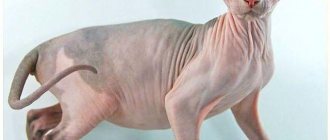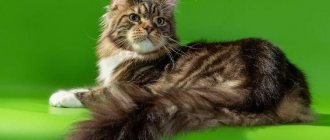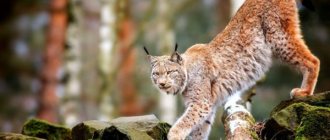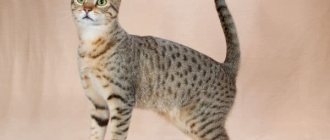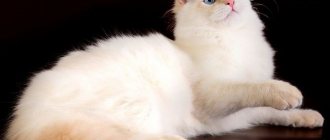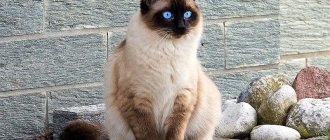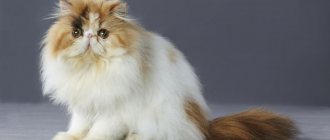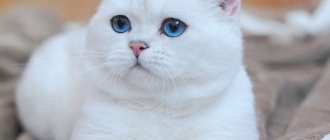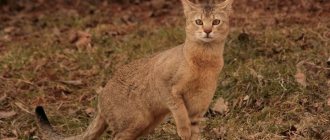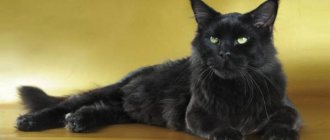Savannah
This is a hybrid breed - a combination of a domestic cat and an African serval. There are 5 types depending on the percentage of wild blood - the highest is the F1 type.
Kittens can cost up to $35,000.
Savannah is large in size. Height at the withers is up to 60 cm, weight is 15 kg. A cat reaches its maximum size by 3 years. The body is oblong with an elongated neck and long legs. The coat is thick and spotted. The ears are large and round, set wide apart, with rounded tips.
The breed is characterized by activity and a calm character. A cat can adapt to any conditions, but room for movement is important to it. The animal likes fresh air and is not afraid of water.
Why do cats eat while standing?
Have you ever wondered why your cats eat while standing? Is she in a hurry somewhere or afraid of something?
In the case of cats, it is difficult to draw any conclusions. These are such unique and original animals that it is difficult to determine the exact code of their behavior.
In many cases, we can only guess at the reasons for certain behavior. Such an analysis should always end with the statement: “it still depends on the character of the cat.” Despite this, we bring up the topic: why do cats eat while standing?
Why don't cats sit down when they eat?
The vast majority of cats eat while sitting. However, there is a charming minority who prefer to stand. Why is this so? There are many hypotheses, but none of them have been scientifically confirmed. Cats are extremely mysterious animals and have not yet revealed all their secrets to us. Every cat has its own food preferences. They are the result of character, the availability of food, its quality, habits or the conditions in which they live. We will try to answer the question: why do cats hold their butts when they eat?
One hypothesis is that standing-eating cats come from environments where food was hard to come by and scarce, so if they caught or got something, they eat quickly and are in a condition to quickly escape. So cats that are insecure, scared and timid will eat this way. The standing position will be a protection for them in case they suddenly have to “kick back.”
Another reason could be an incorrectly installed bowl. or bowls that are too high. Then it is not comfortable for the cat to sit. I need more visibility and access to get all the tasty morsels. Persians with short muzzles can combat this problem in this way; they have difficulty finding tasty morsels.
Why don't cats sit down when they eat? Another explanation is simply their position in the herd. A cat that has a dominant character in the cat community may use its body to cover access to food for others. This is a signal: I am the boss here. You will only eat when I finish. What cruelty, you say. However, this behavior is deeply written into the cat's genes, and you can't accuse the cat's boss of being cruel. A similar hierarchy prevails, for example, in lion prides.
Cat scent
Cat Backs meet many other important goals. The use of scents is one of the main methods of communication for cats. Cats are masterfully equipped in this regard. They use urine, feces and glands distributed throughout the body. Many of them are located only around the base of the tail. When a cat jumps onto your lap, stretches out sweetly and purrs, and a moment later he turns his back, you have the right to consider this not very good behavior. In fact, this is genuine politeness on his part and fits perfectly into the category of cat stereotypes.
Cats use smell signals to study each other and determine their relationships. When friendly animals meet, they have a special greeting ritual. It starts with rubbing your cheeks. This is a signal of friendship. Then the cats rub their sides - this strengthens the friendship. The next step is to raise their tails and sniff each other. For cats, these actions are elements of an exchange of pleasantries. Cats with a tail covering their back during a long-awaited greeting show shyness or uncertainty, and sometimes even fear.
What is a "cat lift"?
Raising the back side also occurs when stroking. Have you ever encountered a situation where you pet a purr and it bends over to the point where its back end is close to levitating? This is the so-called “cat elevator”. Chances are the cat's rear end will be pointed directly at you. “Well, damn it, cat! I want to stroke you, not look at your genitals! You go...” Most people react this way. It will be difficult for Murlik to understand such a refusal. This behavior means a friendly gesture and an invitation to further hugs and affection.
A cat that behaves this way shows us the highest feelings! There is absolutely no offense in this. Of course, here you cannot do without a certain “but”. Not all cats enjoy petting in this area. Don't be surprised when you get some protest when you try to pet your pet's hindquarters!
Genesis of cat behavior
The reasons for this behavior can be seen in the cat's childhood memories. Kittens are born practically helpless. They cannot hear, see, or have the motor skills to move around. They cannot even fit into the nest without the help of their mother. It is she who, by licking them, provokes defecation. From birth, the mother cat takes great care of the cleanliness and hygiene of her children. He uses his tongue to clean all parts of the kittens' small bodies.
But what does this have to do with the behavior of an adult cat? Your pet simply sees you as your mother's successor. Of course he knows that you are not a she, he also knows that you are not a cat. However, as a cat's guardian, you take on the responsibilities of his mother and remind her of your mother. Fear not, however. By showing you its other side, the cat does not expect you to clean it, this reaction is automatic. He's just bringing back good memories.
Other cases
This will mean the hindquarters will move during heat. This is obviously an invitation to a partner. In this case, however, we will have to deal with a completely different tail position. It will be moved to the side instead of being rigid and straight like an antenna.
So why do cats eat while standing? As you can see, there are several theories on this topic. Some of them are even contradictory. It all depends on the cat and the situation it is in. The analysis must take into account all these aspects. However, we already know that there are cat-related behaviors without even touching on food intake. We now understand that when you caress a cat, it can react differently and express its gratitude. Appreciate it instead of throwing it off your lap.
Why can't domestic cats growl?
Why can't domestic cats growl? Although our cats will try very hard, the only thing they can do is meow... Tag "Next"
Do cats manipulate us? The cat meows like a baby to get what it wants!
Do cats manipulate us? The cat meows like a baby to get what it wants! A cat meows for various reasons. But one thing... Tag “Next”
What makes you disgusted with cats?
What makes you disgusted with cats? Apparently cats and people either love or hate each other. It’s hard for us cat lovers to understand why... Tag “Next”
Why do black cats change color? Here are 6 reasons
Why do black cats change color? Here are 6 reasons why is your black cat starting to lose its original color? Have you noticed that his... Tag “Next”
8 Most Emotional Cat Breeds
8 most emotional cat breeds They will win your heart not only with their appearance, but also with their behavior. The cats of these... Tag "Next"
Why doesn't the cat kneel? Can this be changed?
Why doesn't the cat kneel? Can this be changed? Some cats avoid human laps at all costs. Why? Can you... Tag "Next"
Toyger
These cats resemble toy tigers.
A kitten can cost $15,000.
The breed is short-haired. The main background is brown, with dark stripes on the back, chest, belly, paws and tail. The fur is plush, the presence of sideburns on the sides of the muzzle is appreciated. The eyes are small, the eyelids droop slightly. The ears are slightly rounded. Not all organizations have yet recognized the breed.
Housey (chausie)
This breed is the result of crossing a wild jungle cat and an Abyssinian domestic cat, and regularly requires an influx of new wild blood.
The cost of kittens reaches $10,000.
The weight of a cat can reach 10 kg. The body is strong and muscular, the legs are long. Large ears are equipped with tassels (not always). The head is small, the chin is strong, the cheekbones are slightly angular. The eyes are almond-shaped and can be greenish or golden.
It is preferable to keep the Houseie in a spacious enclosure - the animal is active and needs a lot of space to move. The cat loves communication, but will not sit in your arms.
Khao-mani
Thai cat breed with ancient pedigree.
Kittens cost $7,000-10,000.
A distinctive feature of the breed is different eye colors, although this is not necessary; photographers simply prefer this option.
Eyes can be blue, green or amber. The color is white, black and white is possible, but this is rare. The build is average, muscular, height can reach 25-30 cm, weight - 3.5-5 kg. The head is heart-shaped, the ears are large, the eyes are oval.
This breed is characterized by intelligence, curiosity, agility and playfulness. The cat becomes attached to humans and gets along well with children and pets.
Breeds of dwarf cats
Munchkin
Dwarf munchkin cats are very similar to dachshunds - short legs, a long body and a vertical tail (they are often called dachshund cats). They sit not on their hind legs, but on their seat, while resting their tail.
Their color can be different, eye color - from greenish to sky blue. White individuals have eyes of different colors. There are short-haired plush and long-haired munchkins with silky fur.
Munchkins appeared as a result of natural mutation. This feature shortened their legs by more than 2-3 times, without affecting the spine.
By nature, cats are very affectionate and calm, they love to play with children and just lie on their owner’s lap. Despite their short legs, these miniature cats love to explore new things and handle any kind of travel well.
The name is given in honor of the tiny creatures "munchkins" from the book "The Wizard of Oz".
INTERESTING: It is the Lilliputian munchkin from California that is recognized as the smallest cat in the world - he is only 13.33 cm in length.
Munchkins became the descendants of many dwarf cats.
Napoleon
The result of crossing munchkins with Persian cats, weighing from 2.3 to 4 kg. Their round, slightly flattened muzzle and wide-set eyes make them very similar to ordinary Persians. Napoleon can be any color, just like his eye color.
Their disposition is calm and peaceful, they even treat strangers well (which can be dangerous).
Napoleon dwarf cats are a fairly expensive breed due to the difficulty of breeding them. The price of dwarf Napoleons ranges from 50 thousand rubles.
Bambino
Mix of munchkins with the Canadian hairless sphinx, weighing up to 4 kg. Bambino - from the Italian word for "child", was named by the Osborne couple for its tiny size.
Their appearance is specific - large, wide-open ears, a rounded muzzle, bright blue or green eyes and an elongated body without hair.
By nature, they are very good-natured, love to play with children and do not show signs of aggression. They have well-developed muscles and are very mobile.
IMPORTANT: Bambinos have one weakness - they are very susceptible to cold and heat, therefore, they should be protected from sudden temperature changes. In addition, cats are afraid of water, and they need to be bathed often.
Being a rare and not yet widespread breed, bambinos are one of the most expensive breeds. It is often possible to buy a mini bambino cat only abroad, carefully checking the information from the sellers. There are often cases when buyers are deceived by providing cats of the wrong breed.
Minskin
Dwarf hairless cats obtained by crossing Munchkins with the Canadian Sphynx, weighing 1.8-2.7 kg. Their appearance resembles slightly shaggy sphinxes; their fur can be in patches on the face, along the entire length of the paws, tail and ears. The ears are pricked up, slightly rounded, the head is round, the eyes are set wide.
Mini cats of the Minskin breed are unpretentious, adapt well to any conditions and get along well with other animals. They are very affectionate and playful, patient enough to play with children and at the same time very active.
IMPORTANT: Their weak side is the fear of sunburn and severe frosts, which can easily be avoided by wearing them in winter and protecting them from the sun.
Lambkin
A cute and fluffy kitten with curly fur is the result of crossing a Munchkin with a Selkirk Rex. From rexes they have large pointed ears and luxuriant hair, from munchkins they have short legs and height. Their coloring is usually light, with dark paws. Miniature lambkins are great friends for a loving owner - they are very affectionate and love to play.
The name comes from the English word “lamb” (due to its curly fur), which needs to be brushed at least once a week.
Skookum
American Roy Galusha tried for a long time to breed a small cat with fluffy fur, and he managed to do it by crossing the same munchkins with La Perm. They look exactly like their ancestors: short legs, small body and curly hair.
In translation, skukum means “brave, unbending,” which completely defines the character of these furry babies - they are very curious and active. They are also affectionate, sociable and quite quiet.
IMPORTANT: The only condition for keeping them is that they need to be bathed and brushed at least once a week, which gives them pleasure.
Dwelf
Perhaps one of the most amazing species was obtained by crossing a Munchkin, a Canadian Sphynx and an American Curl. Their appearance is quite specific - a hairless body, short legs, large curled ears and piercing eyes.
Their weight ranges from 1.8-3 kg. The color can be completely different - from gray to lilac shades.
Dwelfs are very calm and sensitive; if you inadvertently offend them, they can hide from you for a long time.
They got their name because of their resemblance to mythical elves.
IMPORTANT: To this day, the breed is considered experimental (brought out in 2007), and is not recognized by international organizations. They can only be purchased in North America at a very expensive price.
Kinkaloe
A small breed cat with adorable curled curl ears. Munchkins gave them short legs and a small body. Weight in females ranges from 1.3 to 2.kg, in males 2.2-3.1 kg. Outwardly, they are similar to Napoleons, with the exception of ears and a long tail. They have long, soft fur that needs to be brushed.
Kinkalows have a calm temperament, they are sociable and playful. Their mischievous disposition does not allow them to sit still; they are always on the move.
Bengal cats
They come in different sizes (including dwarf ones), depending on the area of residence. Unusual dwarf “leopards” can quickly go wild without an owner.
Genet
Crossing Bengal cats with Munchkins and Savannah cats resulted in dwarf kittens that look exactly like their wild ancestors. Familiar predatory eyes, silky fur and leopard print.
Despite their origin, genets are very affectionate and friendly, they love to play and explore new things.
Devon Rex
Devon Rex has Small short-haired cats with large pointy ears and a piercing look as if surprised eyes, were first met in England. Their ears are large, slightly rounded, their fur is wavy and even. The colors can be absolutely any, just like the eye color.
Like true Britons, Devons are calm, quiet, very affectionate and curious. They are often called a poodle cat, which is complemented by the fact that they are ready to run after a stick over and over again, bring you toys, etc.
Balinese (Balinese cat)
Tiny cats descended from Siamese cats, which they resemble. They have fairly long fur and a long fluffy tail.
The character of cute Balinese dogs is quite calm, they love to play, and, at the same time, they love peace and quiet. They never show signs of aggression unless they are defending something that is dear to them.
The peculiarity of dwarf Siamese cats is that they are born completely white, and later acquire a characteristic color.
Singapore
Cute cats weighing up to 2.5-3 kg, which appeared in Singapore, where they are a “living national monument” of the country.
They have small, slightly rounded ears, a long tail and a short-haired body of a beige-coffee color.
Singapura cats have a peaceful disposition, they are very sociable, they love to play with children and cuddle on their owner’s lap.
Skif-tay-don
The smallest cat breed is the Scythian Tay-Don, weighing from 0.9 to 2.5 kg. They appeared in Rostov-on-Don, where breeder Elena picked up a cat with four creases on its tail. Mishka (that’s what the cat was called), a few years later, fathered offspring with a Thai woman, Sima, whose tail was a donut.
One of their kittens, very small, with a short tail, became the first cat of the Scythian-Tai-Toy-Don breed. Among other things, miniature cats are characterized by Siamese coloring; much less often they are mink, chocolate or painted.
These little ones have a very pleasant character, they love to play and explore new spaces, become very attached to their owner, get along well with other animals, but will not allow themselves to be offended.
The name is given after the land of the Scythians, its external similarity with Thai cats, the river on which the city is located and its toy (toy). The generally accepted international name for the breed is toybob (toy bobtail).
This breed is bred in Moscow and Yekaterinburg, where you can buy miniature cats.
Bengal cat
The breed is a hybrid of a domestic cat and a Bengal (Far Eastern cat).
The average cost of kittens is $5,000.
Bengal cats have an exotic appearance - spotted or marbled in color, strong and muscular body. The short coat is thick, shiny and silky. The ears are small or medium-sized, slightly tilted forward. The eyes are oval and large, set widely apart.
The breed is characterized by a well-developed hunting instinct; the animal loves to play at any age. From childhood, it must be accustomed to handling; if kept in an enclosure, the cat can become wild. The breed is not dangerous for children and other pets.
Persian cat
This is one of the oldest and very popular breeds. Cats are long-haired and can only live indoors.
The cost of kittens reaches $5000.
Persians have about a hundred different color varieties. Cats are white and black, gray and blue, red and red, cream and purple. The nose is small, wide and snub. The legs are short and muscular. Sizes are medium or large - weight can reach 7 kg. Large eyes are open and round.
Persian cats are characterized by willfulness and stubbornness, but at the same time their character is balanced. The breed is calm, the animal rarely speaks, and has a neutral attitude towards children.
Ragdoll boy, 127,480 thousand rubles
Apart from the winner of first place in the selection, only two ragdoll cats crossed the threshold of 100 thousand rubles. On FarPost, a breeder from Ussuriysk (who also sells a silver-shaded chinchilla) is ready to give away a five-month-old representative of the breed with all the documents, including a veterinary passport, but only “not to Russia.” The kitten cannot be returned; inspection is carried out on site. The owner is considering the option of delivering the animal from Primorye for 10 thousand rubles to the nearest transport company.
Gray cat. Photo: courtesy of Bary Pride Ragdoll Kennel
The first ragdoll was registered in California (USA) in the 1960s. The breed is characterized by reduced muscle tone, which makes its representatives less sensitive to pain. Experts have not yet come to a consensus on the origin of this breed. According to the first version, the ragdoll appeared as a result of crossing the Burmese and white Angora cats. The color of the animal speaks in favor of this version. According to another version, the ancestors of the ragdoll are considered to be long-haired Persians crossed with other breeds (the fluffiness of cats suggests such thoughts). Another version tells a completely unusual story about the appearance of the breed: once upon a time there was a cat, Josephine, who was hit by a car, and due to the injuries she received, she was inactive and phlegmatic for the rest of her days. However, this did not stop her from bringing offspring from a Burmese cat.
Singapura cat
Short-haired breed.
A kitten can cost up to $5,000.
Singapore is characterized by its small size. It reaches 2-3 kg and is the smallest officially recognized cat.
The only color allowed is sepia agouti (golden cream). It appears by the age of six months, and eye color is finally formed only by 1.5 years. The body is compact and strong. Rounded chest, slightly arched back. The tip of the tail is slightly rounded, the paws are small and oval. The ears are very large with a wide base, the eyes are also very large and round.
The Singapura is very affectionate and active, and is easy to train. She becomes attached to her owner and can be intrusive.
Egyptian Mau
An ancient cat breed that was highly revered in Ancient Egypt.
Today, the cost of kittens can reach $5,000.
The breed is short-haired, medium size. The color is spotted, and there are spots not only on the coat, but also on the skin. The color can be silver, bronze or smoky. 2 lines are required under the eyes and on the cheekbones, there should be an M-shaped pattern above the eyes, and a W-shaped pattern at the level of the ears. Almond-shaped eyes should have a green color; up to 1.5 years, a yellow tint is allowed.
The cat is active and sociable; loneliness is not for her. The breed is characterized by excellent vision, smell, hearing and high speed - up to 58 km/h. The cat is very clean and loves water.
Munchkin
This breed is very unusual. Due to their appearance, such cats are sometimes called dachshunds.
The cost of kittens can reach $4000.
The Munchkin has a body of medium length, but its paws are 2-3 times shorter than usual. The head is proportional to the body, the contour is rounded, high cheekbones protrude. The ears are medium or large, proportional to the head, have a wide base, and the tips are slightly rounded. Almond-shaped eyes are large or medium, the color is not related to color. The coat can be short or long.
The munchkin does not stand on its hind legs, but sits on its seat, resting its tail. The cat can spend a long time in this position; it looks like a kangaroo.
Habitat of rusty cats and their role in the ecosystem
This is the smallest wild cat found in Asia. Its distribution areas are India and Sri Lanka. The animal is on the verge of extinction; there are only about 10 thousand individuals left.
Cats live alone and like to spend a lot of time on the ground. In case of danger, the animal quickly climbs a tree. The habitat area of one individual is 15-18 km², which they allow to be violated only by the opposite sex and only during the breeding season.
Rusty cat is no joke, that's what they call a wild feline
Note! Habitats are divided between individuals. The cat does not even allow relatives onto its property. Meetings between animals occur only for mating.
Cats usually give birth to 1-2 kittens per litter after 2.5 months of pregnancy.
Rusty cat in captivity
To preserve the species and introduce people to wild species, rusty cats are bred in captivity. This animal is kept in zoos around the world and by private breeders. In India, the breed is protected in 2 national parks. In 2013, the country decided to breed wild cats in zoos.
Peterbald
The breed is also called Peterbald or St. Petersburg Sphynx. It is hairless, although light fluff or short hair is allowed.
The cost of kittens reaches $3500.
The Peterbald has several skin types. The cat may even lack whiskers and eyebrows. The breed is characterized by a special elegance: the cats are slender, the head is long and narrow, and the profile is straight. Peterbalds have almond-shaped eyes and ears that are large and set to the sides.
This breed does not tolerate loneliness. The cat becomes attached to its owner, is easy to train, and is very affectionate towards people and other animals.
Yorkie chocolate cat
The breed was brought to the USA by accident.
Prices for kittens start from $3000.
The Yorkie has a long, slightly ragged, soft, chocolate-colored coat that may be uneven, spotted or striped as a child. The breed is semi-longhaired. Weight can reach 7-8 kg. The body is medium or large, the muscles are strong, the legs are slender and long. The ears are large and moderately pointed, the eyes are medium-sized and oval in shape, sloping towards the nose. The coloring is uniform.
The breed is sociable and friendly, and is in good health. The cat gets along well with children and becomes attached not to a place, but to a person.
Semi-feral cat breeds that are expensive
Mating with wild cats allows you to achieve large sizes and beautiful colors, but there are also disadvantages. The behavior of hybrids is not always predictable. Kittens of their first two generations pose a real threat to humans, so such animals are usually kept in enclosures and sold exclusively for further breeding.
Savannah ($13,000)
The Savannah is the largest hybrid breed, created by crossing a regular domestic cat and a serval cat. Its maximum weight reaches 15 kg and remains in the first two generations.
INTERESTING!
In 2007, an enterprising man named Simon Brody decided to resell Savannah kittens under the guise of a new breed - Ashers. Thanks to active advertising in the media, the price of animals rose to $27,000, but in the end the fact of fraud was revealed.
The price of a savannah depends not only on its popularity and unusualness, but also on the difficulty of breeding. The main nuances include:
- infertility of males in the first three generations;
- prolonged intrauterine development of fetuses (75 days);
- the difficulty of choosing a partner for mating with a serval.
For families with children, breeders recommend taking the calmest and friendliest pets from the F3 and F4 generations. They are more tolerant of irritants and less actively express their predatory instincts.
“ More about savannah
Chausie ($9000)
Chausie is a hybrid of jungle and Abyssinian cats. The main reason for its high cost is the difficulty of breeding. About half of the kittens in the litter do not inherit external breed characteristics, and most of the males are born sterile.
The weight of the chausie reaches 14-15 kg. Males look the most massive, since their body size is 15-20% larger than that of females. Most representatives have dark spots, or false “eyes,” on the back of their ears. Their absence is not a defect, but reduces the final cost of the animal.
When keeping Chausies, it is important to take into account their hyperactivity. They love jumping and rock climbing, so a small city apartment will be too cramped for them.
“ More about chausie
Safari ($6000)
Safari is the result of crossing Geoffroy's wild cat with Bengal and Siamese cats. These animals are bred mainly in the USA, which explains their small numbers.
The safari, like the chausie, is characterized by pronounced sexual dimorphism. The average weight of males is 13 kg, and females - only 7 kg.
The main feature of the safari is its short and dense fur with a spotted tabby coloring. Thanks to the original pattern of spots and dots, the animal resembles a miniature version of a leopard.
Safaris love to lie at the feet or on the laps of their owners, but do not require constant attention and diligently avoid intrusiveness. They quickly find a common language with dogs and other “mustachios”, and also get along well with children.
Bengal ($2500)
Bengals were created by crossing wild leopard cats with American Shorthairs, Persians and Abyssinians. Thanks to their unusual color, they are included in the TOP 25 “best mustachioed pets” and are very popular among cat lovers all over the world.
INTERESTING!
Bengals, like magpies, love shiny objects. Jewelry left unattended quickly disappears in their hiding places, which are not always found.
Unlike the safari, the Bengal has more modest dimensions. Its weight ranges from 4-9 kg. A coat of similar color has a special “inner” shine, or glitter. It feels like natural silk to the touch.
“ More about the Bengal cat
Sphinx
One of the controversial breeds - some people like it crazy, while others find the appearance of the animals unpleasant.
The cost of kittens reaches $3000.
Sphynxes have no fur - this is a consequence of a natural mutation. The skin is folded, the ears are very large with a wide base, open and erect. The arches of the cheekbones are rounded and strongly pronounced. The eyes are large and lemon-shaped.
Sphinxes are distinguished by intelligence and playfulness, they become strongly attached to their owners and get along well with other animals. Health problems are not typical for the breed. The disadvantage is the need for special care for the skin, since due to the lack of wool it quickly becomes dirty.
Turkish van
One of the oldest domestic breeds.
The cost of kittens starts from $3000.
The breed is semi-longhaired. The classic colors are red and white and creamy white. The physique is average, the muscles are pronounced. The head has the shape of a truncated triangle, the ears are large with a wide base, the tips are slightly rounded. The large eyes are oval-shaped, set slightly obliquely, and can be light amber, blue or of different colors with pink edging.
The Turkish Van is energetic and sociable, with a melodious voice. The cat loves to run and jump, is not afraid of water at all and loves to swim.
Scottish Fold (Scottish Fold)
A distinctive feature of the breed are small ears that are curved forward and downward. This consequence of a gene mutation is also a disadvantage, since the animal may have problems with the joints.
The cost of a Scottish Fold kitten can reach $3,000.
Scottish Folds are of medium size and have a strong and harmonious build. The coat is short, but very soft and thick. The eyes are large and round, set wide apart.
Scottish Folds are distinguished by their cheerful disposition and sociability, their character is balanced. Such cats become strongly attached to people and home. This breed is able to stand easily on its hind legs and has a raspy voice.
Is it possible to buy and how much does it cost?
A rusty cat kitten can cost up to several thousand dollars. The high price is due to the small population of individuals in the world. To buy a spotted baby, you should contact specialized breeders. They guarantee the purity of the breed and give recommendations on how to keep the animal.
It should be remembered that wild animals require a lot of space to realize their hunting instincts. Keeping a rusty pet requires a large area. It is better if he lives in a country house with a large plot, where he can climb trees and hunt small birds.
Important! A balanced diet is required. Vitamin supplements are added to the daily diet.
Although hunting wild rusty cats is prohibited, their population is declining. There is little chance left of meeting the animal in the wild. Thanks to the national program for the conservation of this breed, the rusty cat breeds not only in the natural environment, but also in national parks and nurseries under the control of animal rights activists. However, you can buy such a kitten for your home, but it will be very expensive.
Elf
The breed appeared quite recently (2006) and is a hybrid of the Canadian Sphynx and the American Curl, occupying an intermediate place between them in terms of cost.
For a kitten you will have to pay an average of $2000.
The elf is a hairless cat; any color of the skin and even a pattern on it are possible. The main feature of the breed is the ears with a wide base, they are narrowed at the top, and at the tips they smoothly bend into an arc. The build is average, the body is flexible, there are a lot of folds. Eyebrows and mustaches are represented by single hairs and may be completely absent.
Elves are affectionate and friendly and get along well with children. Cats are sociable and love attention; they get along well with other animals.
Serengeti
The breed is a hybrid. The basis was Bengal cats; Abyssinian, Oriental, European cats and Maine Coon were also used.
The cost of Serengeti kittens can reach $2000.
The breed is large, weight can reach 15 kg (in cats - up to 10 kg). The Serengeti has the longest legs and a long and muscular body. The color is spotted, with ring stripes on the tail. The ears are large, as long as the muzzle or slightly less. The eyes are large and round, set close together, always rich in color and in harmony with the color.
The Serengeti is characterized by activity, curiosity and a love of outdoor games. The cat does not tolerate loneliness and lack of attention well; it may not get along with other pets.
Oriental cat, 65 thousand rubles
Already an adult and titled handsome chocolate point with white color is sold by the Elfendale nursery on Avito. They are ready to send it to any region of the country.
“Excellent pedigree of famous European blood, excellent breed type, wonderful temperament, multiple show winner,” the seller praises the cat.
An adult Oriental cat at an exhibition on November 5, 2016. Photo: Alexander Ratnikov, RIA PrimaMedia
The actual homeland of this breed is also the USA, but the cat was brought there from England, where, in turn, at the end of the 19th century, its direct ancestors were brought from Thailand along with Siamese cats. In America, the mother of the first Oriental was Roofspringer Mahogany Quinn, Havana Brown. After some time, they adopted standards for an independent breed, leaving Havana Brown not just as a color, but as a breed type (European breeders lost it by crossing Thai cats). In 1977, the breed was officially supplemented with other colors, taking the Siamese cat standards as a basis and adjusting some parameters.
Russian blue
There are 4 types of breed: European, Scandinavian, English and North American. Each type meets certain standards. The classic option is a silver-blue coat and green eyes.
The cost of kittens of this breed averages $1,500.
The Russian Blue has a gentle character, the animal is tactful and obedient, but at the same time loves to demonstrate its temper. This breed has a good reaction to human speech, tone and gestures. She has a certain aristocratic quality, but the cat willingly plays with children. May not get along with the dog.
Natural enemies
The most expensive cats in the world and their breeds: top 10
The red spotted cat in the wild is afraid of attacks from large predators and sometimes becomes a victim of dogs. While raising kittens, the mother teaches the kids how to hide and avoid poisonous snakes and tigers. The danger to the population of this breed of cats comes from deforestation, which disturbs the natural habitat of the animals. Animals are forced to leave their places and survive in new lands.
Unfortunately, the rusty cat's main enemy is man. By constantly expanding agricultural land, people are destroying the natural habitat of wild cats. Predators are poisoned by mice that live in fields treated with chemicals against rodents.
American Curl
The breed is characterized by an unusual appearance. Cats come in short and semi-long hair, the second option is more popular.
The average cost of a kitten is $1200.
The American Curl has a medium size and proportional build. The coat is silky, the hairs lie tightly to the body. Eye color varies, but must match coat color.
A distinctive feature of the breed are the ears - they are curled back, wide at the base, and rounded at the tips. The rotation angle should be within 90-180 degrees. The American Curl's ear feature is a genetic mutation.
The breed attracts with its friendliness, high life expectancy and minimum requirements. American Curls are playful, but families with small children are not recommended to have them - the cat may be injured.
Features of cat breeds with long ears
If we compare cats with humans, we can say that all mustachioed pets have disproportionately large ears. The hearing organs consist of 3 parts:
- external, responsible for collecting sound;
- the middle one, transmitting the sound signal to the next section;
- internal, converting sound vibrations into nerve impulses.
In terms of hearing quality, cat breeds with large ears are in no way superior to their closest relatives. They also detect ultrasound and can clearly distinguish the voices of their owners within a range of 3 km.
Thanks to their developed muscles, cat ears have high mobility. This feature is used for nonverbal communication and for directed perception of distant signals. At the slightest noise, the furry “locators” turn towards its source and record the level of possible danger.
The main advantage of long-eared cats is more developed thermoregulation. Under the thin skin of the ear there are a large number of blood vessels.
The larger the size, the faster the blood cools. In hot weather, it actively irritates the ears, making them red and hot. Under the influence of air currents, part of the heat is transferred outward, reducing the overall body temperature.
Another feature concerns care. A large and open canvas collects a lot of dirt and dust, and also produces an increased amount of sulfur. All this attracts pathogenic microorganisms and contributes to the development of ear diseases.
For prevention, it is necessary to remove accumulated dirt every 5-7 days using special products or a cotton pad soaked in warm water or olive oil.
Maine Coon
Recently, the popularity of this breed has increased.
The cost of a kitten is about $1000.
The main feature of the breed is its impressive size - length with tail can reach 1.35 m (35 cm tail), and weight - 8 kg (for castrated males - up to 12 kg). The height at the withers of an adult can be 25-40 cm. If ordinary cats grow up to a year, then the growth of a Maine Coon continues up to 3-5 years.
The breed is long-haired. The coloration is similar to domestic cats, most often brown and smoky tabby. The eyes are expressive, the ears are large, the fur is tousled, the tail is fluffy.
Along with their large size, Maine Coons have a kind and friendly character. They get along well with children and get along with dogs.
British Shorthair
This breed occupies tenth place in our ranking. Britons have a proportionate, dense body with short, thick fur. The most common coat colors are dark blue, chocolate or black. The muzzle is round, with large, wide-open eyes. By nature, these cats are reserved, independent and calm, like true Englishmen.
British Shorthair cats are considered excellent companions.
The history of the breed begins with Ancient Rome - it was from there that cats were brought to the British Isles. In 1871, the first exhibition was held in England, after which breeding of British Shorthairs began. Animals of this breed have come a long way and received official recognition at the international level only in 1984.
Now the cost of a kitten starts from $500 and can reach $1,500; translated into rubles, this amount is about 33,000-98,000 rubles.
